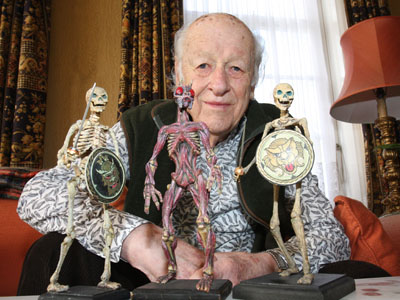
Stop-motion animation would seem to be a dying art in the era of CGI. That it was ever an art had a lot to do with Ray Harryhausen, who died today in London at the age of 92. He didn't invent the technique; just fell in love with it after seeing King Kong…and returning to see it something like eighty jillion times. By the fifties when he supervised special effects for films like The Seventh Voyage of Sinbad, he was the Rembrandt of stop-motion or maybe the Van Gogh or Picasso. Whoever he was, he was the master and everyone else who's done it since has acknowledged him as such.
Details of his career can be found in obits like this one…so I'll just brag that I was able to meet and dine several times with Mr. Harryhausen, usually because we were both hanging around Julius Schwartz and/or Forrest Ackerman. He was a delightful man who was serious about his accomplishments but at the same time, humble about them. I always asked him if he had any plans to animate Julie or Forry who, in their later years, could have used the treatment he gave to other kinds of dinosaurs.
When I was around him, I observed something that I assume was a constant in his life. Guys (always guys, no girls) around my age would approach him, pay him the deserved compliments, then say, "When I was ten, I made a film in my backyard and I animated…" and here they would describe admittedly-dreadful attempts to replicate what Harryhausen did, only with an 8mm camera, a cheap and inadequate model of some kind, and only the vaguest clue as to how to make that model move. For those of you who don't even have the vaguest clue: What you need to do is to train a camera on your model, lock it down on a tripod, then take one frame of film, move the model slightly, take another frame, move it ever-so-slightly, take another frame, etc. It takes a long, long time and doing it in your backyard is Mistake #1 because it can take all day to achieve a few seconds of finished film and the lighting is never consistent when you're outside.
One time, I told Ray that I'd tried it, too — and I said to him, "I learned a new technique and I wondered if you'd mind if I told you about it…because it might help you in your work." He looked at me like I was completely out of my mind. Believe me: I know that look. This was like a kid who'd learned how to remove a splinter presuming to give advice to a top brain surgeon…but Harryhausen was polite and willing to hear me out. I said, "I find that it enhances the animation if you can manage to accidentally get your hands into the shot every seven or eight frames." I then experienced one of those horrible "Uh-oh, he doesn't get it" moments before he threw back his head and laughed. He had a good laugh.
He said, "You'd be amazed how many kids come up to me and tell me they tried to do what I do." I wasn't amazed because even in our limited time together, I'd seen it. He then said something I wish I could quote here verbatim about how people said his legacy was all those great movies but he thought maybe it was all those kids. Few of them went on to actually do stop-motion for a profession but a lot became animators in other senses and a lot became writers or other kinds of filmmakers. You have to admire a guy who inspired so many creative people…and who was just about the best at what he himself did.